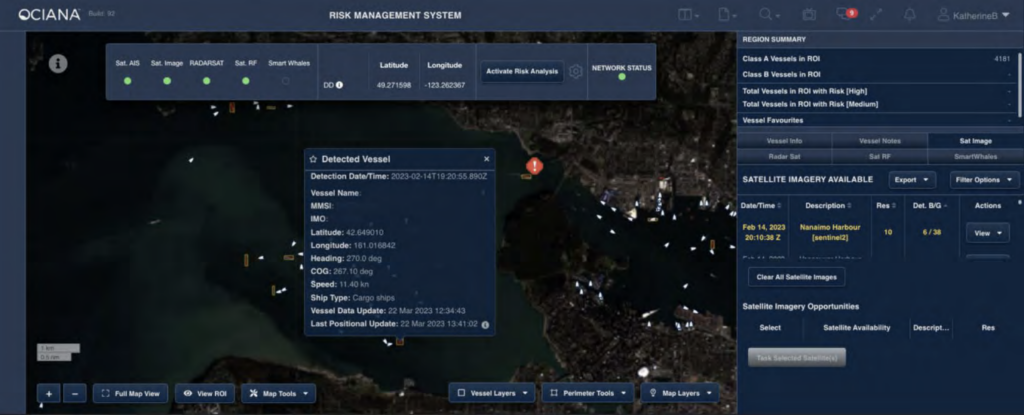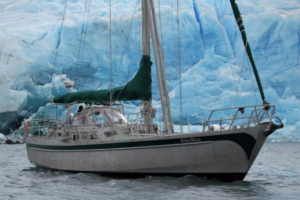Maritime transportation is a crucial aspect of global trade, with millions of vessel voyages worldwide every year. However, the ocean also serves as a hub for illegal activities, including smuggling, piracy, human trafficking and the narcotics trade. These activities pose a significant threat to national security and public safety. Therefore, monitoring vessel movements and identifying suspicious activities are critical elements in the daily fight to prevent criminal activities and promote national security.
Dark Vessel Detection (DVD) is an innovative method that leverages machine learning and data analytics to detect and track suspicious vessels. DVD enables maritime authorities to identify suspect vessels in near real-time, enabling prompt responses to potential threats.
Challenges of Monitoring Suspicious Vessels
One of the primary challenges of monitoring suspicious vessels is the sheer volume of maritime traffic. Hundreds of thousands of ships, on any given day, are tracked by global maritime monitoring across the oceans, making it challenging to identify vessels engaged in illegal activities. Additionally, traditional surveillance methods, such as radar and visual surveillance, are limited in their ability to detect and track suspicious vessels. Automatic Identification System (AIS) tracking has emerged offering much more advanced monitoring capabilities.
Criminals have adapted their behaviour in response to authorities’ vessel traffic monitoring capabilities, developing novel tactics to evade detection such as disabling AIS transponders, using false identification data, or spoofing their location data. These tactics make it challenging to identify suspicious vessels, even with advanced surveillance methods.
Organizations around the world use the term “dark vessels” when referring to vessels that hide their identity and/or do not correctly broadcast their status according to international regulations. With increasing availability of advanced sensors onboard earth observation satellites, there is new potential to detect and monitor illegal at-sea activities of vessels.
The Solution
GSTS has developed a Dark Vessel Detection (DVD) capability to help organizations around the world better monitor large areas of the ocean. This capability has wide application across the maritime sector at sea.
OCIANA™: An AI Powered Platform to promote security through enhanced maritime awareness
GSTS’ maritime AI platform, OCIANA™ rapidly ingests and processes a variety of earth observation satellite data (radar and optical), simultaneously with other data sets describing ocean conditions, weather, port activity, vessel history, and global-scale satellite AIS vessel information. GSTS has developed an AI-powered DVD capability that derives intelligence through the fusion of several of these global monitoring datasets. This capability utilizes a combination of deep learning models, geospatial analysis, and bespoke analytics informed by our subject matter experts to flag suspicious vessels that have turned off their AIS transponder or altered information pertaining to the vessel, voyage or intentions.

How Dark Vessel Detection Works in OCIANA™
GSTS has developed a Dark Vessel Detection (DVD) capability to help organizations around the world better monitor large areas of the ocean. This capability has wide application across the maritime sector at sea.
DVD is a data-driven approach that leverages deep learning and data analytics to detect suspicious vessels. DVD uses a range of data sources, including AIS data, satellite imagery, and historical vessel movement data, to create a comprehensive view of maritime traffic.
OCIANA™: Dark Vessel Detection to monitor illegal activities in real-time
DVD uses deep learning models to detect vessels using optical and radar imagery, which enables detection and monitoring regardless of existing weather conditions. The detection models identify vessel locations and attributes through a process that fuses AIS messages with imagery and other satellite derived data. Fusion facilitates the identification of any vessels that have turned off or altered their AIS transponder data.
DVD can also be used as a predictive model to anticipate suspicious activities. For example, if a vessel is detected moving towards a high-risk area, such as a known piracy hotspot, DVD can alert maritime authorities to investigate further.
DVD offers several benefits to maritime authorities, including:
- Enhanced Maritime Security: DVD enables maritime authorities to detect and track suspicious vessels, allowing them to take prompt action to prevent criminal activities
- Cost Savings: DVD is a cost-effective solution that leverages existing data sources, reducing the need for new data acquisitions
- Real-Time Monitoring: DVD provides near real-time monitoring of vessel movements, allowing authorities to respond quickly to potential threats
- Predictive Analytics: DVD leverages predictive modeling to anticipate suspicious activities, enabling authorities to take proactive measures
OCIANA™ Use Cases:
I. Dark Vessel Detection for Enhancing Sovereignty and Saving Lives
At the height of the COVID-19 pandemic during the summer of 2020, a brave adventurer decided to attempt a sailing of Canada’s Northwest Passage after the Federal Authorities had closed the Arctic to all but essential shipping, in order to protect isolated aboriginal communities with limited access to tertiary healthcare.

Dark Vessel Detection (DVD) technology was at its infancy, but as a world leader in exploiting spacebased AIS, GSTS was able to periodically track the passage of the Kiwi Roa during those occasions when the master turned on the vessel’s AIS-B transponder.

But for much of the transit, the location of the Kiwi Roa remained unknown. This posed a problem not only from a health protection point of view but more importantly a SOLAS perspective. The Kiwi Roa’s captain, Peter Smith, completed his voyage without incident but had he encountered problems, the closest SAR assets were more than 1200 Nm to the South in Winnipeg.

Over the last three years, GSTS has enhanced its DVD technology so it can provide choke point surveillance along much of the Kiwi Roa’s route. Ship sized objects are automatically detected using satellite imagery and if there is no associated AIS track in the vicinity, an alert is sent to the operator (as can be seen in the southeast quadrant in the image above).
DVD can enhance a government’s Maritime Domain Awareness by providing a truer representation of what is happening on the water. Vessels that don’t comply with AIS regulations can be identified and targeted for further investigation by other on-water and/or airborne surveillance assets. In the Canadian Arctic, OCIANA™ could form the backbone of an Arctic surveillance and SAR system, especially if updates were made to NORDREGS requiring the mandatory carriage of AIS-B by all vessels less than 300 tonnes.

II. Dark Vessel Detection in in Support of Sanctions Enforcement and Environmental Protection
As criminal activities such as smuggling, transhipment of embargoed goods, and the on-going practice of trade with sanctioned countries continues, DVD has become an increasingly crucial tool for identifying vessels engaged in such activities.

Transhipment is a common problem in terms of sanctions busters skirting legitimate authorities by masquerading the origin of goods being sold, be it food, illegal arms, and ultimately oil. Within the context of the current Russian-Ukranian conflict, oil is being transshipped to tankers under flags of convenience both in the midAtlantic and off the cost of North Africa. The problem is not merely one of sanctions enforcement but also environmental protection. Most reputable shippers using reputable flags of registry replace their vessels every 15-20 years as both safety and hull integrity diminish over the course of merchant service.
 During the last 18 months, there has been exponential growth in a “shadow fleet” to meet demand. Vessels that would normally be taken out of service are now being repurposed to perform dangerous transfers at sea, all the while being re-flagged in countries with little to no safety standards, enforcement regime, and most importantly, without marine insurance. Therefore, when (not if), there is a maritime environmental disaster, there will be little recourse to recoup the clean up cost.
During the last 18 months, there has been exponential growth in a “shadow fleet” to meet demand. Vessels that would normally be taken out of service are now being repurposed to perform dangerous transfers at sea, all the while being re-flagged in countries with little to no safety standards, enforcement regime, and most importantly, without marine insurance. Therefore, when (not if), there is a maritime environmental disaster, there will be little recourse to recoup the clean up cost.
 May 23, 2023 Oil Spill in the Red Sea as reported in Group Captain, a ship suspected of 150-Mile-Long Oil Slick in Red Sea. By combining AIS data with imagery, the list of culprits was narrowed down to three vessels.
May 23, 2023 Oil Spill in the Red Sea as reported in Group Captain, a ship suspected of 150-Mile-Long Oil Slick in Red Sea. By combining AIS data with imagery, the list of culprits was narrowed down to three vessels.
Dark vessels, which operate with their AIS switched off, are challenging to detect and pose both a significant security and environmental risk. However, fusing satellite imagery data with AIS and other sources provides a means of identifying these vessels and then targeting them for action. OCIANA™ leverages both optical and SAR satellite images to monitor vast areas of the ocean. By using these advanced technologies, the ability to detect dark vessels and promote maritime security is enhanced.
GSTS’s platform, OCIANA’s pattern-of-life capability can detect activities that vessels are engaged in based on their kinetic signatures. These inferences can be fused with DVD data to isolate risky and unusual vessel behaviours linked to patterns of interest, such as smuggling, transhipment of banned goods, and infrastructure sabotage. The platform can then be configured to establish surveillance areas and “keep-out” zones so that authorities can be alerted to either the presence of a suspect vessel or its imminent arrival. OCIANA’s ETA algorithms are so advanced that they can predict the arrival of a target vessel up to 28 days in advance of its arrival.




Advantages of Dark Vessel Detection Capability with OCIANA™:
There are several benefits to organisations from investing in Dark Vessel Detection capabilities including:
- Enhanced Maritime Domain Awareness: DVD technology operates as an analytical tool which facilitates detection and tracking of vessels that are not transmitting AIS signals, facilitates historical analysis and pattern of life analytics thus providing a more comprehensive understanding of maritime activities in a given area of interest.
- Improved Security: By detecting and monitoring dark vessels, maritime security forces can better identify potential threats, such as illegal fishing, smuggling, and piracy, and respond appropriately to prevent or mitigate such activities.
- Better Enforcement: DVD can enable authorities to enforce maritime regulations and laws more effectively through the effective cueing of other limited surveillance and enforcement resources, to support missions such as the monitoring of compliance with fishing quotas or the maintenance of sanctions on certain goods or countries.
OCIANA™ DVD capabilities thus enables innovation which leverages deep learning and data analytics to detect and track suspicious vessels. DVD provides a cost-effective solution to monitor maritime traffic and identify potential criminal activities. DVD also offers near real-time monitoring, predictive analytics, and enhanced maritime security, making these capabilities indispensable for maritime authorities.
Contact us to learn more today: sales@gsts.ca



